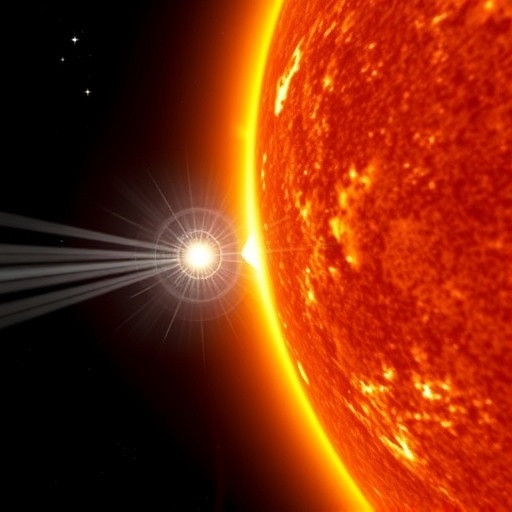In a monumental leap for solar physics, researchers have, for the first time, captured direct evidence of small-scale torsional Alfvén waves undulating through the Sun’s corona, a region of immense heat and mystery. These twisting magnetic waves, elusive since their theoretical prediction more than eight decades ago, offer critical insights into one of the longest-standing enigmas in astrophysics: why the Sun’s outer atmosphere, or corona, is dramatically hotter than its surface below.
Using the cutting-edge capabilities of the Daniel K. Inouye Solar Telescope (DKIST) in Hawaii—the most powerful solar telescope in existence—scientists have observed these minute but persistent torsional Alfvén waves with unprecedented clarity. Unlike previous observations which detected larger, isolated Alfvén waves typically associated with solar flares, this discovery pertains to the continuous, small-scale twisting motions believed to play a fundamental role in energy transport throughout the solar atmosphere.
The Sun’s corona, visible during total solar eclipses, sizzles at temperatures exceeding one million degrees Celsius, starkly contrasting with the relatively cool 5,500 degrees Celsius at the solar surface. This inverted temperature gradient, long confounding scientists, suggests the presence of processes efficiently channeling and dissipating energy from the Sun’s interior into its outer atmosphere. Torsional Alfvén waves—magnetohydrodynamic disturbances predicted by Nobel laureate Hannes Alfvén in 1942—are now poised as a prime candidate for this energy transfer mechanism.
Dr. Richard Morton, lead researcher and UKRI Future Leaders Fellow at Northumbria University’s School of Engineering, Physics, and Mathematics, spearheaded the effort to isolate these twisting waves from the coronal plasma’s complex motions. “The corona’s plasma is dominated by swaying or ‘kink’ wave motions, which mask these torsional oscillations,” Morton explains. “By innovating novel analytic techniques to disentangle these overlapping signals, we could finally detect the faint signatures of twisting magnetic field lines, confirming the existence of torsional Alfvén waves.”
The DKIST’s Cryogenic Near Infrared Spectropolarimeter (Cryo-NIRSP) was instrumental in this breakthrough. This state-of-the-art instrument leverages a four-meter primary mirror—four times larger than previous solar observatories—to capture exquisite spectral data in the near-infrared range, areas where plasma movements induce distinctive red and blue Doppler shifts. Analyses of these spectral signatures allowed researchers to infer fast, opposite-directed plasma flows on either side of magnetic flux tubes—hallmarks of torsional wave activity.
Previous approaches struggled to resolve such twisting waves because their transverse velocity amplitudes are relatively small compared to more conspicuous wave phenomena. The sophisticated algorithm developed for this study subtracts out the dominant kink wave-induced swaying, effectively unmasking the underlying torsional components. This novel methodology opens a new window to understanding how Alfvénic turbulence drives coronal heating and solar wind acceleration.
The implications of this detection are profound. The coupling of these small-scale torsional waves with ambient magnetic fields may facilitate plasma heating to extraordinarily high temperatures, potentially solving the solar coronal heating puzzle—a cornerstone question of heliophysics. Moreover, the energized plasma subsequently escapes as a supersonic solar wind stream, embedding space weather effects that influence satellite operations, GPS functionality, and terrestrial power grids.
The consortium behind this discovery reflects global collaboration, uniting expertise from Northumbria University, Peking University, KU Leuven, Queen Mary University of London, the Chinese Academy of Sciences, and the NSF National Solar Observatory. Together, they have refined instrumental, analytical, and theoretical frameworks that advance our grasp of magnetohydrodynamic wave dynamics in stellar atmospheres.
Furthermore, this breakthrough sheds light on the nature of ‘magnetic switchbacks’—sudden reversals in the Sun’s magnetic field observed by NASA’s Parker Solar Probe. Emerging evidence suggests these switchbacks may be energized by torsional Alfvén waves, contributing to the transport of energy and momentum within the solar wind, thus linking fundamental solar physics to heliospheric phenomena.
Professor Morton emphasizes the transformational potential of this discovery: “Having direct observations of torsional Alfvén waves allows us to rigorously test and validate theoretical models of wave-driven corona heating and solar wind physics. It represents a milestone—bridging the gap between long-standing theories and tangible astrophysical evidence.”
Looking ahead, the team anticipates that DKIST’s Cryo-NIRSP will foster further exploration of wave dissipation mechanisms, nonlinear plasma interactions, and energy cascade processes in the corona. These investigations will be crucial in refining space weather forecasts, vital for safeguarding Earth-based and orbital technologies.
This landmark study, published in the October 2025 issue of Nature Astronomy, follows earlier contributions by Professor Morton this year, including in-depth examinations of high-frequency coronal Alfvénic waves and their origins. Collectively, this research trajectory underpins a new era of high-resolution solar wave physics and positions the DKIST as an essential tool in unravelling the Sun’s dynamic magnetized environment.
In summary, the direct detection of small-scale torsional Alfvén waves complements and extends our understanding of solar magnetoacoustic phenomena, offering long-sought answers to coronal heating and plasma acceleration. This discovery not only enriches the fundamental physics of our closest star but also has practical consequences for predicting and mitigating the effects of solar activity on Earth’s technological infrastructure.
Article Title: Evidence for small-scale torsional Alfvén waves in the solar corona
News Publication Date: 24 October 2025
Web References:
Nature Astronomy article DOI: 10.1038/s41550-025-02690-9
Northumbria University Research Portal: Richard Morton
References: Morton et al., Nature Astronomy, October 2025.
Image Credits: NSF/NSO/AURA/J. Williams
Keywords
Space sciences, Astronomy, Solar physics
Tags: astrophysical wave dynamicsDaniel K. Inouye Solar Telescopeenergy transport in solar atmospheremagnetohydrodynamics in astrophysicssmall-scale magnetic wavessolar atmospheric phenomenasolar corona heat anomalysolar physics advancementssolar physics researchsolar surface versus corona temperaturesSun’s corona temperature mysterytorsional Alfvén waves discovery





